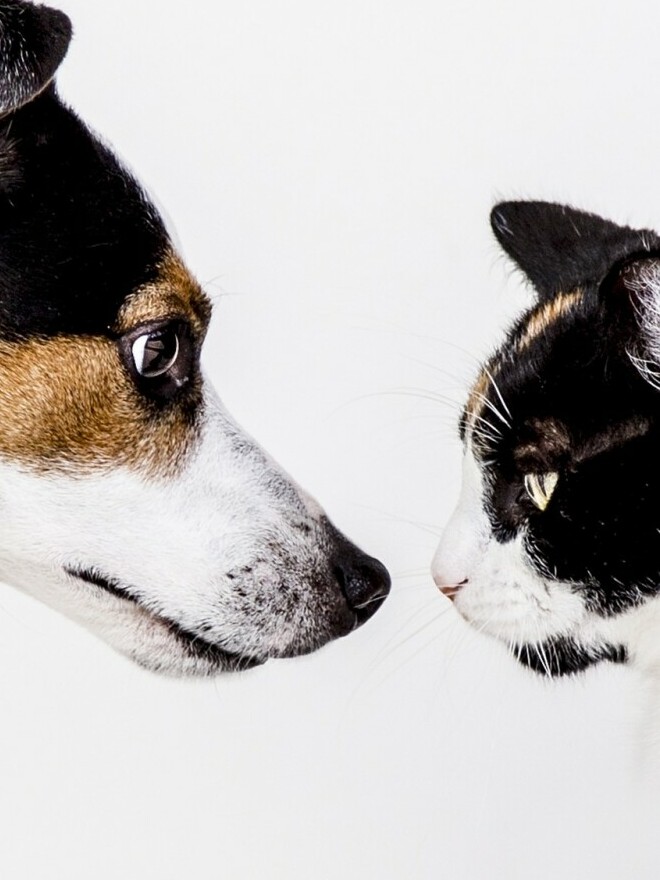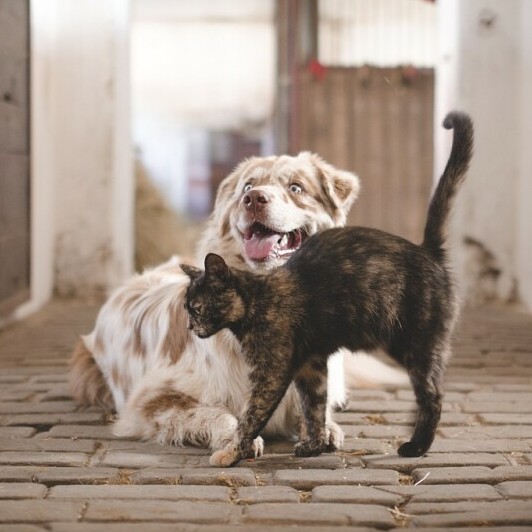
A few of the links in this post are affiliate links. If you buy something, we may earn a small commission (no extra bones from your wallet 🐾). Thanks for helping support the site and all of the dog adventures!
You might be wondering why your loving pooch suddenly seems to flip a switch when a cat is in sight. It’s not as simple as an old cartoon rivalry; it’s deeply rooted in canine behavior. Dogs have a strong predatory drive, an instinct that can be more pronounced in some breeds than others.
When they see something small and fast-moving, like a cat, it can trigger their chase response. And that can result in an utterly chaotic household. So we’re here to help you avoid this with our tips on how to get your dog to stop chasing the cat.
When examining why dogs chase cats, we have to look at their body language and signals. It’s a complex conversation without words. A dog might see a cat’s tail flick or darting movements as an invitation to chase, while the cat might just be feeling playful or anxious. It’s this misinterpretation of cues that often leads to a chase, even if the dog has no intention of harming the cat.
We’re here to help you with understanding individual temperaments as well. Just as people have unique personalities, so do our pets. The dog’s breed may play a part, but it’s not the whole story.
Your dog’s past experiences, age, and even energy level all contribute to how they interact with your cat. A young, energetic dog, for example, might be more inclined to chase simply because it has excess energy to burn.
That’s going to include looking at solutions to this common problem. Training and environment management are key. Keep reading, because up next, we’re going to tell you about proactive ways to discourage your dog from treating your cat like a sprinting buddy and how to channel their energy into more appropriate activities.
Effective training strategies are key to stopping unwanted behaviors. Learn more in Positive Reinforcement vs. Punishment: Which Works Best?
Looking for fresh dog food delivered? Click here.

Proactive Solutions to Prevent the Pursuit
We’re going to tackle an issue many pet owners face: dogs chasing cats. This isn’t just about stopping a noisy kerfuffle; it’s about creating peace in your home for both your furry friends. So, how do you keep Fido from turning your living room into a racetrack?
First things first, you want to give your cat some room to breathe – literally. Carve out a cat-only zone that’s off-limits to your dog. This can be a spare room or a corner with a tall cat tree.
Cats love vertical space, which not only keeps them out of reach but also gives them a sense of security. It’s important for the cat to have a safe area to keep from having confrontations.
Next up, managing your dog’s energy is key. If your dog has enough exercise, he’s less likely to have the zoomies and target your cat. Regular walks, runs, and even dog sports can help burn off that chase impulse.
Think of these activities as a way to ‘reboot’ your dog’s energy levels. Lots of issues can be solved with your dog if you keep them active and help them expend their energy.
Don’t forget the power of distraction and positive reinforcement. When your dog focuses on something other than your cat, like a toy or treat, give plenty of praise. It’s a clear message that chasing isn’t the way to win your approval. Let them know that playing with you is more beneficial than messing with the cat.
Now, after setting these measures in place, you’re going to find out about training your dog for a more harmonious household in the next section. Stick with us here, and we’ll discuss transforming your pet’s chase game into a thing of the past.
Early training sets the stage for a well-behaved dog. Start with Puppy Training Basics

Training Your Dog for Harmony at Home
If you want to alleviate the tension between your dog and cat, it’s crucial to start with intentional training. We’re going to walk you through some effective methods to cultivate a peaceful atmosphere for both your furry friends.
Gradual Introductions: Don’t rush it. Begin by allowing the dog and cat to be aware of each other’s presence without direct interaction. Separation by a baby gate or having the dog on a leash during initial encounters can manage the situation more safely. Let them get comfortable being in the same house without making it seem like a constant standoff.
Reward Good Behavior: When your dog is calm or ignores the cat, that’s your cue to praise and treat. Over time, they’ll associate the presence of the cat with positive experiences.
Command Training: Commands like ‘leave it’ or ‘stay’ are invaluable. Train these commands in a cat-free environment before attempting them in shared spaces. Consistency is key. Let your dog be aware that you disapprove of them bothering the cat.
Set Boundaries: Your home has to have rules, and your dog should know them. If the couch is the cat’s safe zone, make sure your dog respects that. Consistent reinforcement of these boundaries is crucial.
Your first attempt doesn’t need to be your last; patience will be your best friend in this process. Remember, each positive interaction is a step closer to a harmonious home. It will be worth it in the long run.
Chasing cats is a common issue. Find solutions in Common Dog Behavior Problems and How to Fix Them.

Fostering Friendship: Encouraging a Peaceful Coexistence
So the question for you today is: how do we move from chaos to cohabitation? By now, you’ve got a good grasp of why dogs chase cats and the practical steps to train your dog and manage their environment. But there’s a final piece to this puzzle — turning your fur babies from foes to friends.
If you want to see your dog and cat getting along, patience is your best friend. Start with short, supervised sessions where both animals can see and sniff each in a controlled setting. Celebrate small victories, like a peaceful mealtime or a shared nap in the sun.
Choose something that resonates with you and your pets when encouraging interactions. Maybe it’s a mutual love for a particular treat or a fascination with a certain toy.
Invest time in these shared moments, and you’re going to find out about the powerful bond that can grow between species. We’re willing to bet that the best time for family time will be around dinnertime.
Don’t worry too much about occasional setbacks. Every pet is unique, and sometimes they take two steps forward and one step back in their relationships.
This isn’t just about preventing your dog from chasing your cat; it’s also about creating a harmonious home where every member, regardless of species, feels safe and loved.
Remember, consistency is key. Ensure each encounter between your dog and cat is positive, and over time, their tolerance of one other can blossom into a form of mutual respect, or even affection.
Remember, your first attempt doesn’t need to be your last. Adjust your approach as needed, always with love and patience at the helm.
We really hope that this guide has bolstered your confidence in managing a multi-pet household. A lot is happening very quickly when you introduce or support a dog-cat dynamic.
But with the strategies we’ve shared, you’re well-equipped to nurture a peaceful and playful atmosphere. Your pets rely on you to lead the way – and we believe you can do it. Can’t we all just get along?
If you have multiple pets, managing dynamics is crucial. Tips are in Balancing Multi-Dog Households.
Looking for fresh dog food delivered? Click here.

